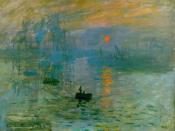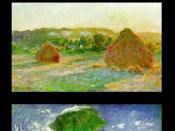Impressionism
All art movements have emerged from changing ideas and perspectives on the world and time period of an artist or group. Art movements can form through any number of things such as new discoveries of perspective, rebelling against what is the correct way to create artworks and the changing world of the time. Impressionism is about the way in which the human mind is able to processes what it sees, the everyday lives of the middle class and the influences of scientific discoveries thus making Impressionism a rebellion against the artistic standards of the Academie des Beaux-Arts. This approach to art expresses the quality of modernity. Impressionism is about the temporary, focusing on the here and now rather than the timeless qualities seen in the standards of the Academie des Beaux-Arts. One the these artists was Claude Monet who's work entitled 'Impression sunrise' inspired the movements name and was of strong influence to the beginnings of Impressionism.
Impressionism is a 19th-century art movement that originated with a group of Paris-based artists called the Anonymous Society of Painters, Sculptors, Printmakers, etc. In the 1860's, a group of French painters rejected the current ideas about painting and tried to free themselves of rules and traditions to portray their immediate impression of a subject. These painters attempted to achieve a convincing depiction of the light in their landscapes, townscapes and portraits. This was achieved with loose, short strokes of the brush or with dabs of unmixed paints so that they could record their impressions on the canvas. These artists organized an exhibition in Paris that launched the movement known as Impressionism. Their independent exhibitions gained them prominence in the 1870s and 1880s despite the harsh opposition from the French art community. The exhibit marked a rebellion against the...


